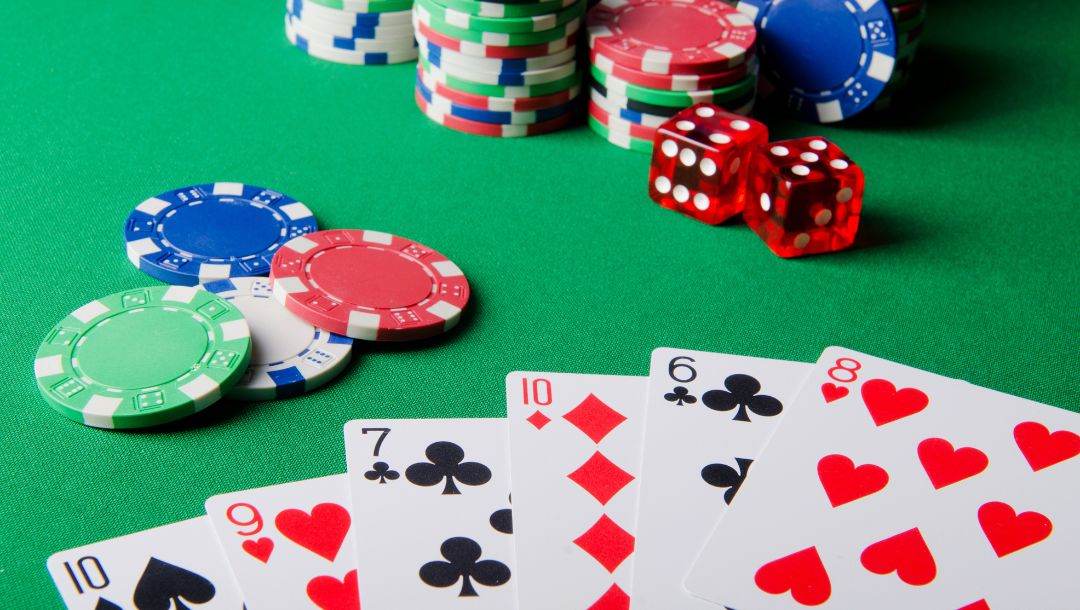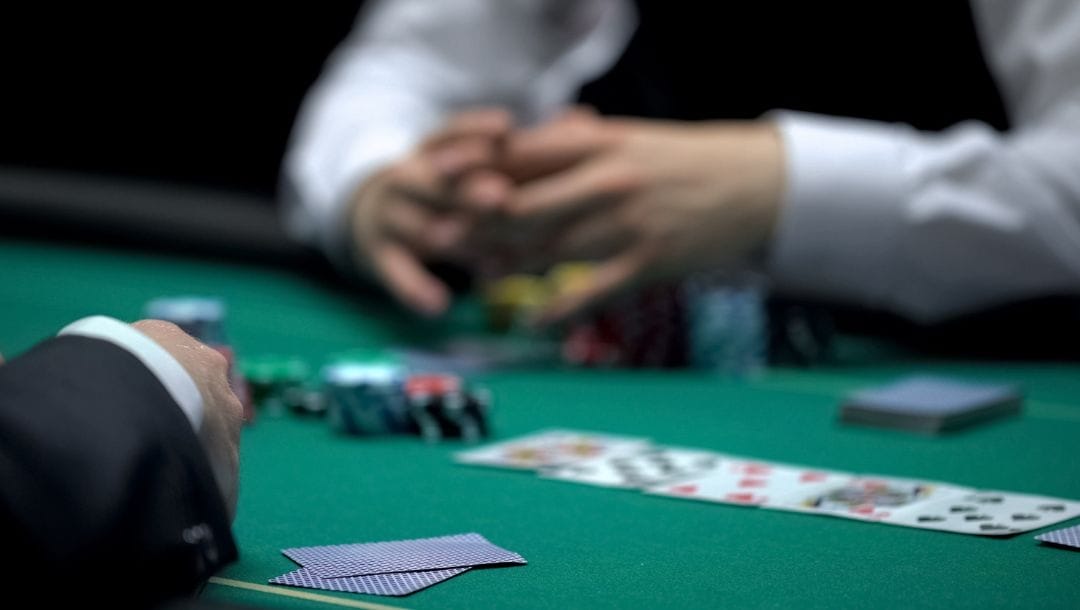A gutshot straight draw, also known as an inside straight draw, is perhaps an underrated hand. It’s certainly not as strong as its cousin, the open-ended straight draw. But if you learn to play it correctly, it can be a very strong weapon to have in your arsenal.
Whether you prefer to play poker online or in a land-based cardroom, the advice in this guide will help you master this often troublesome hand.
What Is a Gutshot in Poker?
Before delving into the strategy discussion, it’s important to cover the basics. In poker, “gutshot” is a term that refers to a specific type of straight draw.
Whenever you have four cards to a straight, that’s a straight draw. But if the required card is somewhere in the middle, as opposed to the end of the straight, that’s an inside straight draw. Colloquially, this is usually referred to as a “gutshot.”
Gutshot Draw Examples
Imagine playing Texas Hold’em, and you have a 9 of spades and an 8 of spades. The flop is a king of diamonds, 10 of clubs, and 6 of spades. If the turn or river cards bring any of the four 7s, you’ll complete a 10-high straight. Here it is an inside straight draw, or gutshot draw.
What about if the flop was king of diamonds, 10 of clubs, and 7 of spades instead? This is also a straight draw. But here, any 6 or jack completes the straight. Because both ends of the straight are open to draw, this is easier to hit than a gutshot. And, of course, it’s dubbed an “open-ended straight draw.”
Inside Straight-Draw Probabilities

One can explore this idea a little further. With two cards to hit, the open-ender is obviously more likely to come in. But how much more likely?
Whenever you flop an inside straight draw, you have a maximum of four cards to hit. Five cards are already known to the players at the table, meaning there are 47 unknown cards left in the deck:
(4/47)*100 = 8.51% (odds of -1,075.)
If you don’t hit the draw on the turn, you have another card with which to complete your gutshot. Now, the math looks like this:
(4/46)*100 = 8.70% (odds of -1,049.)
Open-Ended Straight Draws
Compare that to an open-ended straight draw, where you always have eight outs, and of course, it’s twice as likely to complete.
(8/47)*100 = 17.02% (odds of -488.)
And if you miss the turn, the chance of hitting on the river is:
(8/46)*100 = 17.39% (odds of -475.)
Pot Odds
A fundamental part of formulating the right gutshot straight poker strategy is centered around pot odds. This is the ratio between the size of the bet and the pot after you make the call.
Imagine the heads-up opponent bets $5 into a $20 pot. It’s therefore costing the player $5 to win a $25 pot, giving odds of +400 against. What does this mean for the strategy on the turn?
Well, knowing that the chances of hitting the gutshot are just 8.51%, the player must fold. To play this pot, the player will need to win 20% of the time just to break even. But the hand’s equity is only -1075, so they know that calling would be a losing long-term play.
Drawing to the Nuts
Another important consideration is that not all draws are created equally. Imagine you’re holding a 5 of diamonds and 4 of diamonds on a board of 3 of clubs, 7 of spades, and 9 of clubs. If any 6 appears, you’ve made a seven-high straight. However, anyone with a 10 and 8 of the same suit has a better straight, so your hand is not guaranteed to win.
This is an important consideration if you’re going to play such slim draws. A gutshot will not come in often, so you’d better make sure that it wins you the pot when it does.
Another factor is that completed gutshots don’t just lose to higher straights. They’re also vulnerable to flushes and, to a lesser extent, full houses and straight flushes. Don’t assume that the hand is over once you fill your gutshot. Consider the texture of the board and act accordingly.
Combination Draws

Similarly, it’s not usually a good idea to draw to a bare gutshot. But if you can combine it with other draws, it can be a powerful hand. By adding in a flush draw, not only does the hand’s equity jump considerably, but it can be a well-disguised hand when it hits.
Consider an 8 of diamonds and 6 of diamonds against an ace of hearts and king of hearts on a board of 5 of diamonds, 9 of diamonds, and ace of clubs, compared to a board of 5 of diamonds, 9 of spades, and ace of clubs. With the former, you’re a marginal underdog, with an equity of -113 in the hand. You can make your inside straight, but you can also hit a flush, running two pair or trips, and even a straight flush.
But in the latter, where you only have the gutshot draw and miraculous runners to call upon, your total equity plummets to just -352.
Double Gutshot Draw
Another example of a well-disguised inside straight draw is the “double gutshot,” or “double gutter.” The probabilities here work out exactly like an open-ended draw since you also have eight outs. But it’s nowhere near as obvious to your opponents because you have a combination of two distinct gutshots.
For example, your hand is a queen of hearts and 8 of hearts on a board of a king of clubs, 10 of diamonds, 9 of spades, and 6 of clubs. Any of the remaining jacks in the deck give you a king-high straight, while any 7 completes a 10-high straight.
Tips for Winning With Gutshot Draws
Here are some practical examples of playing a gutshot effectively, which you can work into your own game. Remember, optimal poker strategy is always changing, and you should be, too.
You Can Slow Down
Many novice poker players make the mistake of continuing to bet too frequently. There’s no law that says if you raise preflop, you have to make a continuation bet. Your opponents will expect this and likely check to you anyway. So, a lot of the time, you can slow down and check it back, taking a free shot at hitting your draw.
This will also ensure that you don’t bluff too frequently and that you’re harder to read in the long term. And everyone knows that unpredictable poker players are the toughest to play against.
Out of Position Against Multiple Opponents
When playing multiway pots out of position, it’s important that you don’t get too aggressive. A big part of a gutshot’s value comes from fold equity.
If you can turn it into a semi-bluff and get your opponent to fold, there’s no need to hit the draw. But the more opponents you’re against, the harder it will be to force it through. Particularly when out of position.
Ready to Hit Some Gutshots at BetMGM?
Now that you’ve mastered the inside straight draw, it’s time to put this knowledge to the test. Head to BetMGM and register today. You’ll find a wide variety of online poker tournaments and cash games to suit all bankrolls.










